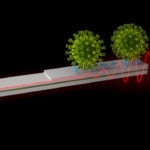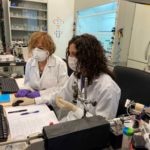The Spanish researcher behind a new rapid coronavirus detection test
Laura Lechuga, research professor at Spain's National Scientific Research Council (CSIC) and group leader in the Catalan Institute of Nanoscience and Nanotechnology (ICN2), is heading up the ambitious CoNVaT project. CoNVat aims to produce a rapid, inexpensive, and highly sensitive test for diagnosing COVID-19 from the first day of infection. “It won't only indicate if the virus is present or not, but it will also reveal its concentration. This is important because it gives an idea about how advanced the infection is,” she explains. The new test should be ready in less than a year, in time for future waves of the pandemic.

Laura Lechuga, a 2016 recipient of one of the prizes awarded by the Spanish Royal Physics Society and the BBVA Foundation, is responsible for the research initiative which has more than €2 million in funding from the European Union. This research is one of the projects selected in Europe’s fast track call for proposals to combat COVID-19, within the framework of Horizon 2020 and through which the University of Barcelona, France's University of Aix-Marseille, and Italy’s National Institute of Infectious Diseases are all collaborating.
The tests they are working on are biosensors and use nanophotonics to detect the virus’ proteins and its genetic material. Lechuga invented these type of nanobiosensors and has significant experience prepping them for use with clinical samples for various pathologies. Hence, the project has been able to commit to being ready in less than a year, a timeframe that includes a verification phase with a high number of patients.
The main advantage this test has over others is it uses a chip to administer photonic interferometry, one of the most sensitive measuring techniques in physics. “The technique is so sensitive that it can detect the presence of the virus from the first day of infection,” Lechuga explains. “And it won't only indicate if the virus is present or not, but it will also reveal its concentration. This is important because it gives an idea about how advanced the infection is” she explains. The sensor is based on the idea that when a beam of light intersects with an object, it experiences small, but measurable, changes that will indicate the presence of the virus in the sample.
A low-cost test that doesn't require qualified personnel
The test can be administered in health clinics and sample collection points; specialized technicians are not required, as opposed to the PCR (polymerise chain reaction) tests; it is expected that saliva samples will be used and results will be available within 30 minutes. The testing device will be the size of a shoe box, but at its core, where the measurement will be taken, everything will occur on a nanometric scale.

Laura Lechuga in the lab - Instituto Catalán de Nanociencia y Nanotecnología (ICN2)
The researchers call it a nanotrap for proteins: they affix proteins on a chip, proteins designed to trap those proteins that are are found on the virus, to accommodate them. In the chip, nanometer-wide channels through which light can pass have been recorded. These channels act as a roadmap, creating a single-entry circuit that then forks, in such a way that only one of the branches passes through the protein trap. When both light beams meet again, modifications in the light beam that has interacted with the proteins can be observed. Analyzing these changes reveals the presence and concentration of the virus.
The device that detects the virus’ genetic material is based on the same principle, but it has to be analyzed in a laboratory. Lechuga explains that its goal is fundamentally to confirm the result of the initial test.
Experience putting nanotechnology to use
“One of the reasons why the CoNVaT project has had the support we have had is because we have experience with clinical trials, which really is a different world from the laboratory,” she explained. It is an extremely sophisticated technology that has already been clinically validated. ICN2’s Biosensors and Bioanalytical Applications Group, led by Lechuga, has developed (among others) nanobiosensors used to detect early-stage colon cancer in blood samples and tuberculosis and cases of sepsis.
“In this type of device, the biological part is by far the most complex,” she explains. Anchoring the proteins to the chip at the correct angle, stabilizing them so they don't move, keeping them in a liquid medium, etc. “all this takes something like 30 steps.”
The goal, at the end of the project, is to be able to position a company to take on the large scale ramping up of the technology so that it can be offered to the market at an affordable price. “Especially at a time like now, we do our work with the idea that it has to reach everyone, as soon as possible,” she concludes.